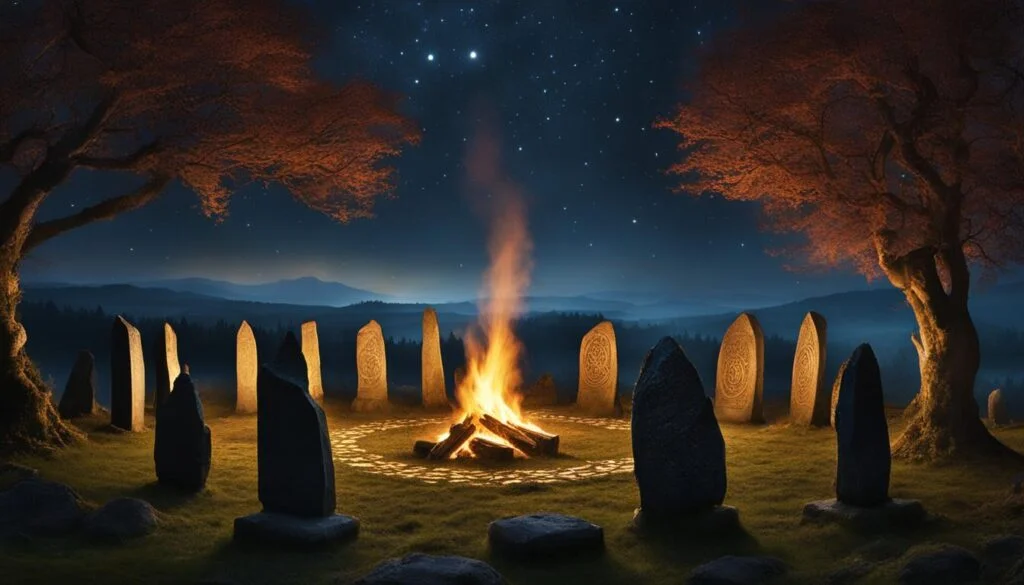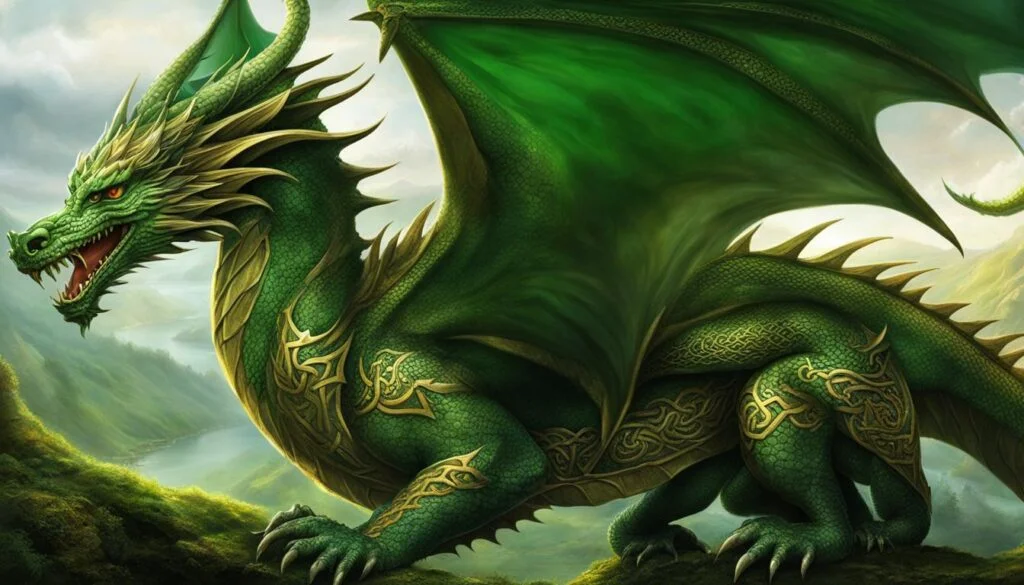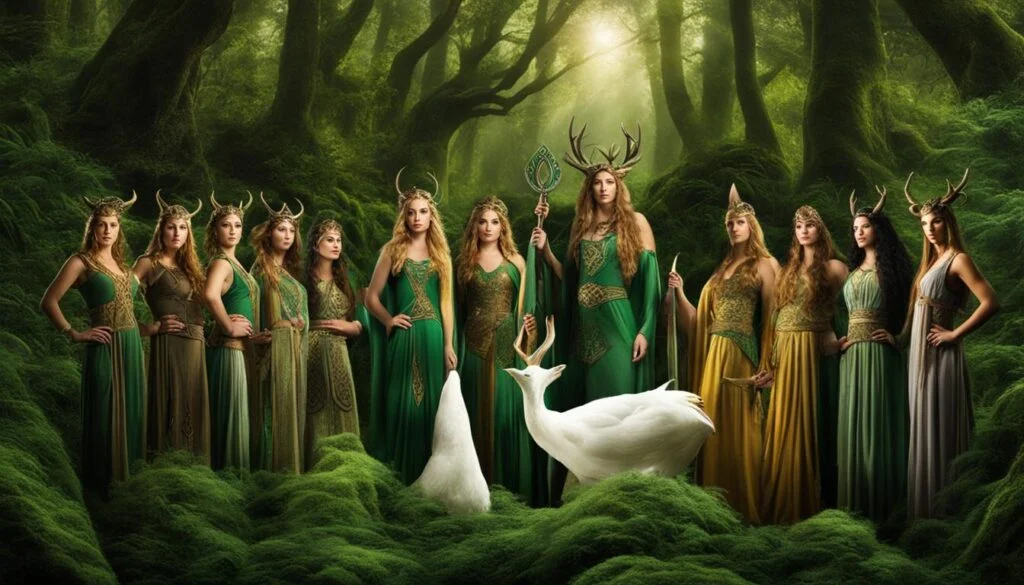Samhain, also known as the Celtic Festival of the Dead, is a highly significant tradition in Celtic culture. This ancient festival is steeped in rich history, customs, and spiritual beliefs that continue to influence modern-day celebrations.
Samhain marks the division of the year between the lighter half (summer) and the darker half (winter). It was believed to be a time when the boundary between the earthly realm and the Otherworld was at its thinnest, allowing spirits to pass through. The Celts celebrated Samhain by engaging in various rituals, wearing costumes and masks, and gathering around bonfires to honor their ancestors and ward off harmful spirits.
Key Takeaways:
- Samhain is an ancient Celtic festival steeped in tradition and spirituality.
- The celebration marks the transition between the lighter and darker halves of the year.
- Celts engage in rituals, wear costumes, and gather around bonfires during Samhain.
- Samhain is a time to honor ancestors and ward off harmful spirits.
- The festival holds deep symbolic meaning in Celtic spiritual beliefs.
The Origins of Samhain
Samhain, the ancient Celtic festival that has become synonymous with Halloween, has its roots in Celtic Ireland dating back approximately 2,000 years. This festival, with its deep spiritual and cultural significance, predates the arrival of the Celts and holds a place in the prehistoric Irish culture.
The Boyne Valley, located in Celtic Ireland, was home to two hills intimately associated with Samhain – Tlachtga and Tara. Tlachtga was the site of the Great Fire Festival, which marked the beginning of Samhain celebrations on the eve of Halloween. The Hill of Tara, also connected to Samhain, aligned perfectly with the rising sun during this time. These ancient sites provide evidence that Samhain was revered and celebrated long before the arrival of the Celts, further deepening its historical significance.
As we explore the origins of Samhain, it becomes clear that this ancient Celtic festival has endured throughout the years and continues to capture our fascination with its rich cultural heritage.
Samhain Traditions and Customs
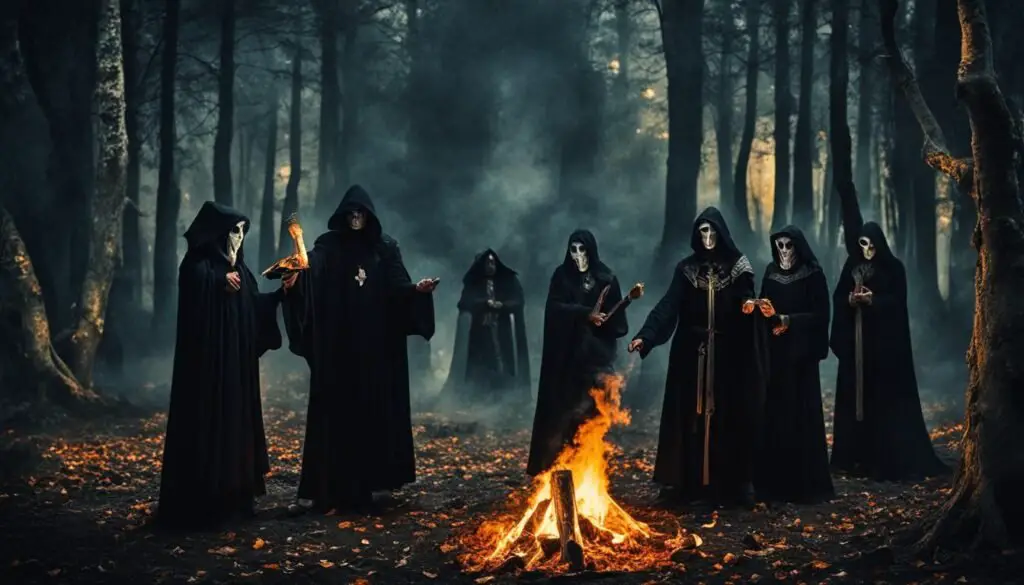
Samhain, the ancient Celtic festival, was characterized by a rich tapestry of traditions and customs practiced by the Celts. These practices aimed to honor ancestors, ward off harmful spirits, and embrace the spirit of the festival.
- The Celts would don costumes and masks as a way to disguise themselves from harmful spirits, believing that by appearing like these spirits, they would avoid any harm.
- Bonfires played a significant role in Samhain festivities. They symbolized the transition between seasons and served as a communal gathering point for celebrations. The bones of slaughtered livestock were cast into the bonfires as an offering.
- Household fires were extinguished during Samhain and then rekindled from the bonfires. This act represented the renewal of light for the coming year, symbolizing the cycle of life and death.
- Food held great importance during Samhain. It was prepared for both the living and the dead, with offerings made to honor ancestors. Sharing food was a way to strengthen familial and communal bonds.
- Another crucial aspect of Samhain was the practice of warding off harmful spirits. The costumes, masks, and bonfires were employed as protective measures against these entities.
As depicted in the image, the costumes, masks, and bonfire represent the key elements of Samhain practices. The altar adorned with food offerings symbolizes the act of honoring ancestors, while the community gathering exemplifies the spirit of sharing and connection during this festival.
The Evolution of Samhain into Halloween
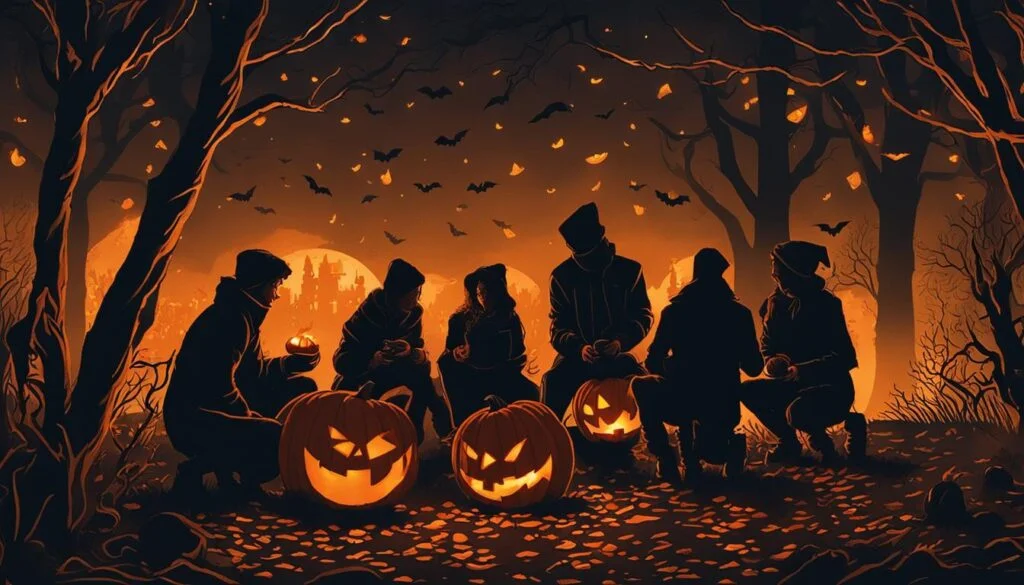
Incorporating elements of Samhain, Christianity introduced All Saints’ Day on November 1st and All Souls’ Day on November 2nd into its calendar. These Christian holidays retained certain customs associated with Samhain, such as the honoring of the dead and the tradition of wearing costumes and masks to ward off harmful spirits. These practices eventually blended with other Halloween customs, giving rise to the modern celebration of the holiday.
Halloween customs and traditions reached new heights when Irish emigrants brought their traditions to the United States during the 19th century. Over time, Halloween became one of the major holidays of the year in America, evolving and incorporating new elements along the way. One prominent addition was the American practice of carving pumpkins into Jack-o-lanterns, which replaced the traditional use of turnips in Irish tradition.
Samhain Symbolism and Spiritual Beliefs
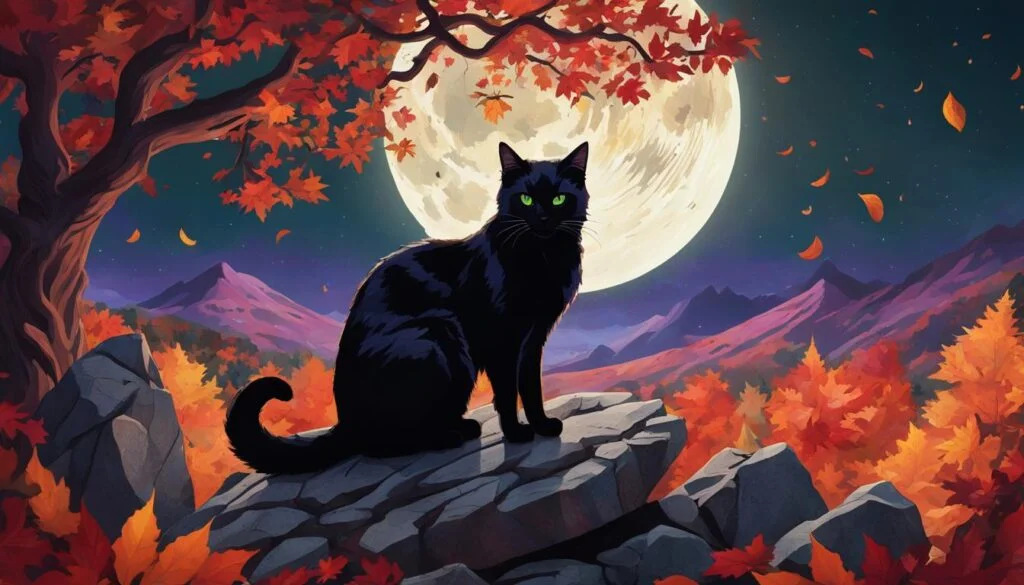
Samhain, a significant festival in Celtic spiritual beliefs, carries profound symbolic meaning. It embodies the cyclical nature of life and death, as the transition from the lighter half of the year to the darker half represents the movement from life to death. During Samhain, the boundary between realms is believed to be thinnest, allowing the spirits of the dead to return to the earthly realm.
To honor and appease these spirits, special rituals and offerings are made. This sacred festival provides a powerful opportunity for the Celtic community to connect with their ancestors and gain spiritual insight into the mysteries of life and death.
The symbolic significance of Samhain is deeply ingrained in Celtic spiritual beliefs, reflecting their reverence for the cycle of life and death and their understanding of the connection between the physical and spiritual realms.
Mythology and Samhain Stories
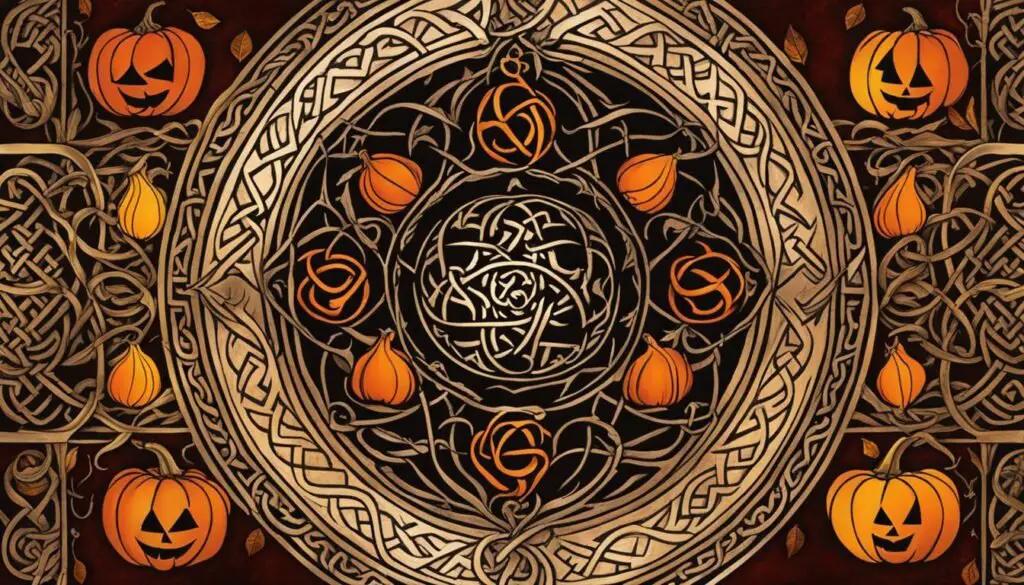
Mythology plays a significant role in the traditions and customs associated with Samhain. Ancient Celtic tales are deeply intertwined with the essence of this festival, giving it a rich mythical backdrop.
One of the most renowned stories is the epic Second Battle of Mag Tuired. This captivating tale recounts the fierce conflict between Celtic gods and malevolent oppressors during the sacred time of Samhain. The battle represents the eternal struggle between good and evil, showcasing the significance of this festival in Celtic mythology.
The Adventures of Nera and Fionn mac Cumhaill are two other captivating tales that highlight the prominence of Samhain. These mythical stories follow the heroic quests of Nera and Fionn mac Cumhaill, showcasing their encounters with supernatural beings during the festival. Through these courageous tales, we glimpse the extraordinary feats of Celtic heroes and their connection to the spirit of Samhain.
These ancient Celtic tales illustrate the profound association between Samhain and the mythological tapestry woven by Celtic heroes. They not only provide entertainment but also offer insights into the cultural significance and spiritual beliefs surrounding this ancient festival.
Ancient Samhain Celebrations and Customs
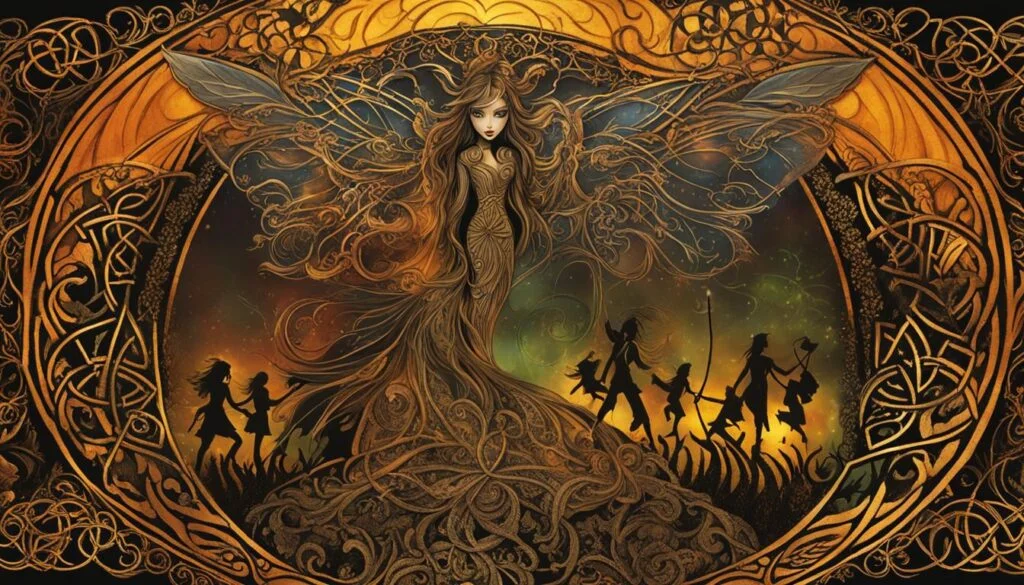
Ancient Samhain celebrations were marked by vibrant community gatherings and rich customs. These seasonal festivals were filled with profound symbolism and ritual practices that honored the transition from the lighter half of the year to the darker half. Let’s explore some of the fascinating ancient Samhain practices:
Bonfires: Protection and Cleansing
The lighting of bonfires was a central element of Samhain celebrations. These fires served as a source of protection and cleansing. The flames were believed to ward off negative energies and evil spirits, creating a sacred and safe space for the community to gather.
Sacrifices: Ensuring a Bountiful Winter
Ancient Celts made sacrifices during Samhain to appease the spirits and ensure a prosperous winter season. These sacrifices often included livestock, which were ritually slaughtered and their bones cast into the communal bonfire. The act of offering these sacrifices was a way to express gratitude and seek blessings for the well-being of both the people and the animals.
Offerings to Fairies: Protecting against Abduction
Samhain was believed to be a time when fairies, also known as Sidhs, would roam freely and could potentially kidnap humans. To prevent such abductions, people would leave offerings for the fairies, such as food or small trinkets. These offerings were meant to appease the fairies and ensure their goodwill for the coming year.
Mythological Creatures: Shapeshifters, Monsters, and More
Samhain was associated with various mythological creatures in Celtic folklore. Pukah, shape-shifting entities, were believed to roam the land during this time. The headless Lady Gwyn and the horse-riding Dullahan were also seen as supernatural beings associated with Samhain. These creatures added an air of mystery and intrigue to the festival, capturing the imagination of the ancient Celts.
Divination: Unveiling the Future
Divination was a significant part of Samhain celebrations. Nuts and apples, symbolic of wisdom and abundance, were often used for fortune-telling. People would engage in various divination practices, such as apple peeling, where the length of the peel would reveal insights about future love or marriage. This practice allowed individuals to seek guidance and gain insight into their destiny.
Ancient Samhain celebrations were a time of deep spiritual significance and communal unity. The customs and rituals practiced during this seasonal festival honored the cycle of life and death, while also fostering a sense of connection with the Otherworld and the spiritual realms. As we delve into the history of Samhain, we gain a deeper appreciation for the ancient traditions and cultural heritage that continue to resonate with us today.
Samhain in the Middle Ages
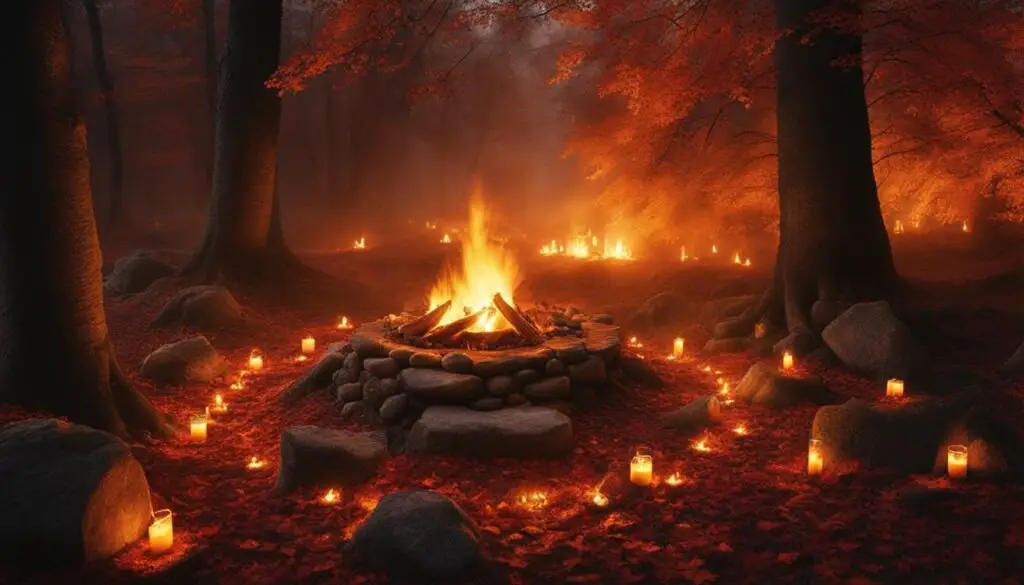
During the Middle Ages, Samhain celebrations continued with new traditions and customs. The festival, deeply rooted in ancient Celtic beliefs, evolved as it interacted with the Christian influence of the time.
One of the key elements of Samhain in the Middle Ages was the lighting of bonfires, known as Samghnagans. These bonfires served a dual purpose–to protect against fairies and witches and to provide warmth and light during the colder months.
Another notable addition to Samhain during this period was the use of carved turnips, which eventually evolved into the Jack-o-lanterns we associate with Halloween today. These carved turnips or Jack-o-lanterns were placed on windowsills to ward off evil spirits and bring good luck.
Costumes and games also became a part of Samhain celebrations in the Middle Ages. People would dress up as ghosts, witches, or other supernatural beings, parading through the streets and playing pranks on one another.
A unique tradition that emerged during this time was the practice of Dumb Supper. Families would gather for a silent dinner where empty places were set for deceased loved ones. This custom allowed families to interact with the spirits of the dead and offer them food as a sign of remembrance and respect.
This blending of Pagan and Christian customs during the Middle Ages ensured that the spirit of Samhain continued to thrive, making it a significant festival even in the changing landscape of Christianized Europe.
Christian Influence and Samhain
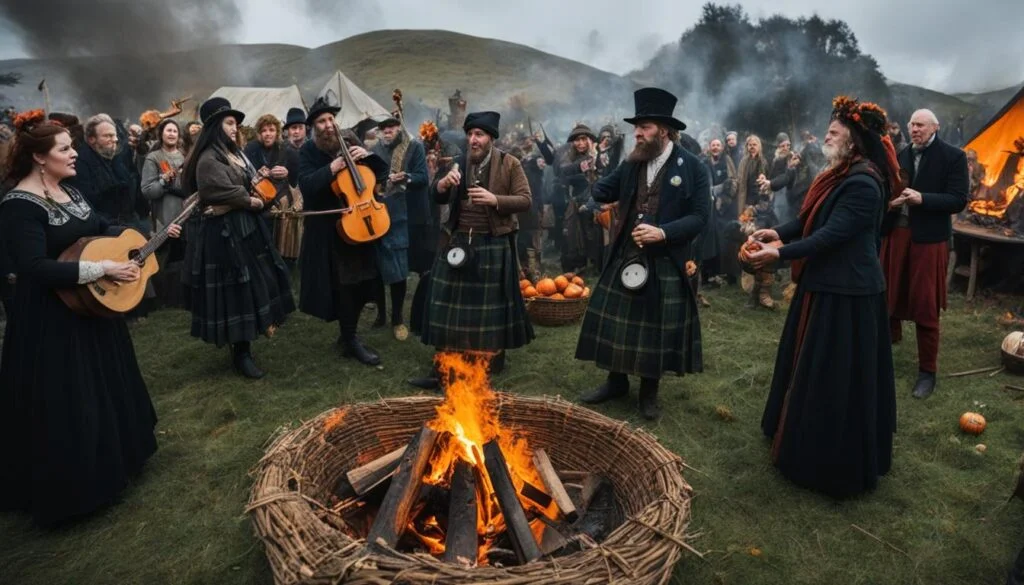
The Christianization of Samhain can be seen through the establishment of All Saints’ Day and All Souls’ Day. These Christian holidays were strategically placed around the same time as the traditional Samhain festival, incorporating elements of both honoring the saints and the souls of the dead.
All Saints’ Day, also known as All Hallows’ Day, is celebrated on November 1st. It is a day dedicated to honoring all the saints and martyrs recognized by the Catholic Church. All Souls’ Day follows on November 2nd and is a time to remember and pray for the souls of all the faithful departed.
The influence of Samhain on Halloween traditions can be traced back to Irish and Scottish immigrants who brought their customs to America. Halloween, which is derived from “All Hallows’ Eve,” retains elements of the Celtic festival, such as wearing costumes and going door-to-door for treats.
The blending of the traditional Samhain festival with Christian holidays and the incorporation of immigrant customs played a significant role in the popularization and evolution of Halloween into the celebration we know today.
Irish and Scottish Immigrants
Irish and Scottish immigrants were instrumental in the preservation and adaptation of Samhain traditions. These immigrants brought their customs to America, particularly during the 19th century, when a wave of Irish emigration occurred due to the Great Famine.
The Irish and Scottish immigrants contributed to the development of Halloween in America by bringing elements of their Samhain celebrations. The practice of wearing costumes and going door-to-door for treats, known as “guising,” originated from these traditions.
This image represents a cultural melting pot, showcasing the influence of Irish and Scottish immigrants on Halloween traditions.
Modern Observance of Samhain
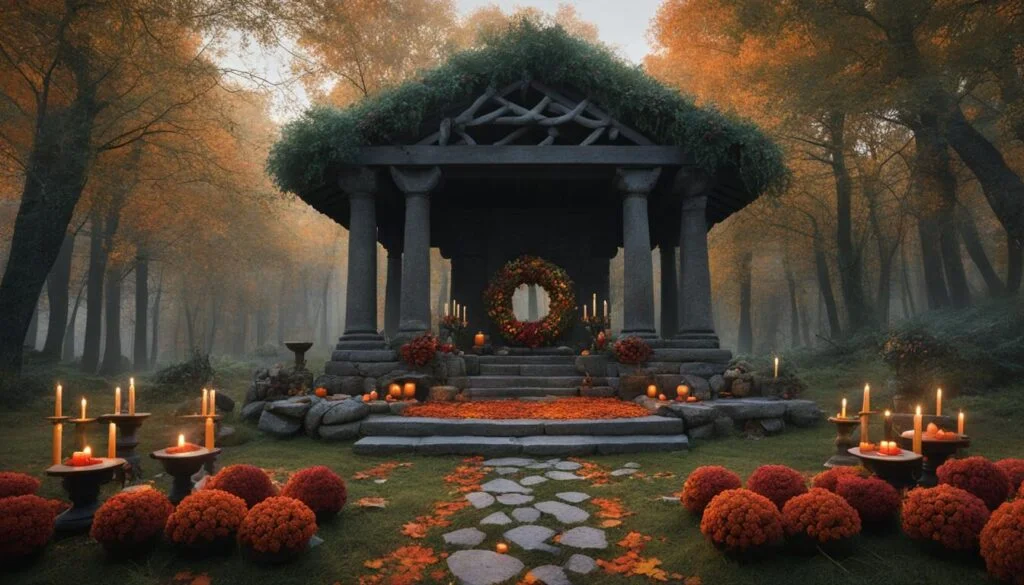
In the modern era, Samhain continues to be observed by various pagan and Wiccan communities. It has experienced a revival among those who follow Celtic neopaganism and seek to honor the ancient traditions. Wiccans, in particular, celebrate Samhain as a time of transition and communion with the dead, often incorporating elements of the festival into their religious practices.
In addition to Wicca, Celtic Reconstructionists also strive to authentically practice Samhain based on historical and cultural research. They aim to recreate the rituals and customs of the Celts, as closely as possible, in order to honor the spirit of Samhain.
Modern observances of Samhain may include various activities such as rituals, bonfires, feasts, and music and dance events. One notable event is the Witches’ Balls, which are held in some communities and serve as a gathering for modern pagans to honor nature and ancestors in the spirit of Samhain.
Conclusion
Samhain, as an ancient Celtic festival, held immense significance for the Celts. It served as a momentous occasion marking the transition between seasons and providing a connection with the Otherworld and the spirits of the dead. Embedded deeply within Celtic spiritual beliefs, Samhain beautifully portrayed the cycle of life and death while affording the opportunity to honor ancestors and gain spiritual insight.
Throughout history, the traditions and customs of Samhain have evolved and influenced various cultural practices, ultimately giving rise to the modern celebration of Halloween. Today, Samhain continues to be observed by neopagans and individuals who seek to reconnect with their Celtic heritage. It serves as a profound reminder of our ancient roots and cultural heritage.
By celebrating Samhain, we cherish not only an ancient Celtic festival but also embrace the spiritual beliefs and cultural significance it holds. This festival reminds us of the cyclical nature of life and death and the importance of honoring our ancestors. Samhain continues to shine a light on the rich tapestry of Celtic tradition and invites us to explore our spiritual connection with the supernatural realm.
FAQ
How was Samhain celebrated by the Celts, and what did it symbolize?
Samhain was celebrated by the Celts as an ancient festival marking the division between the lighter half and darker half of the year. It symbolized the transition from life to death and represented a time when the spirits of the dead could pass into the earthly realm. The Celts honored their ancestors, wore costumes and masks to ward off harmful spirits, and participated in bonfires and feasts.
What are some of the ancient Celtic customs associated with Samhain?
Some of the ancient Celtic customs associated with Samhain include wearing costumes and masks to disguise oneself as harmful spirits, lighting bonfires for protection and cleansing, preparing food for both the living and the dead, and making offerings to honor ancestors. These customs aimed to ward off harmful spirits while welcoming back the spirits of loved ones.
How did Samhain evolve into the celebration of Halloween?
Samhain influenced the establishment of Christian holidays such as All Saints’ Day and All Souls’ Day. Halloween traditions, such as wearing costumes and going door-to-door for treats, were inherited from Irish and Scottish immigrants who brought their customs to America. Over time, other traditions, such as carving pumpkins, were added, resulting in the modern celebration of Halloween.
What is the symbolic meaning of Samhain in Celtic spiritual beliefs?
Samhain holds deep symbolic meaning in Celtic spiritual beliefs. It represents the cycle of life and death, with the transition from the lighter half to the darker half of the year symbolizing the movement from life to death. During Samhain, it was believed that the spirits of the dead would return to the earthly realm, and special rituals and offerings were made to honor and connect with them.
Are there any mythological stories associated with Samhain in Celtic tradition?
Yes, there are several mythological stories associated with Samhain in Celtic tradition. The Second Battle of Mag Tuired portrays the conflict between Celtic gods and evil oppressors during the festival. The Adventures of Nera and Fionn mac Cumhaill also feature Samhain as a significant backdrop for heroic quests and encounters with supernatural beings. These stories highlight the importance of Samhain in Celtic mythology.
What were some of the ancient Samhain celebrations and customs?
Ancient Samhain celebrations revolved around community gatherings and customs. Bonfires were lit for protection and cleansing, sacrifices were made to appease spirits and ensure a bountiful winter, and offerings were left for fairies to prevent them from kidnapping individuals. Samhain was associated with various mythological creatures and monsters, and divination using nuts and apples was a significant part of the festivities.
How did Christian influence impact Samhain?
Christian influence on Samhain can be seen in the establishment of All Saints’ Day and All Souls’ Day, which were placed around the same time as the traditional festival. Halloween traditions, such as wearing costumes and going door-to-door for treats, were inherited from Irish and Scottish immigrants who brought their customs to America. The Christianization of Samhain played a role in the popularization and evolution of Halloween as we know it today.
How is Samhain observed in modern times?
Samhain is observed by various pagan and Wiccan communities in the modern era. It has experienced a revival among those who follow Celtic neopaganism and seek to honor the ancient traditions. Wiccans celebrate Samhain as a time of transition and communion with the dead, often incorporating elements of the festival into their religious practices. Celtic Reconstructionists strive to authentically practice Samhain based on historical and cultural research.
Why is Samhain considered significant in Celtic culture?
Samhain is considered significant in Celtic culture because it represents an ancient Celtic festival that held deep symbolic meaning. It marks the transition between seasons and represents a connection with the Otherworld and the spirits of the dead. Samhain played a crucial role in Celtic spiritual beliefs, reflecting the cycle of life and death and providing an opportunity for honoring ancestors and gaining spiritual insight.


